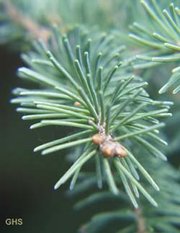Spruce
|
|
| Spruces | ||||||||||||
|---|---|---|---|---|---|---|---|---|---|---|---|---|
 Norway Spruce (Picea abies) | ||||||||||||
| Scientific classification | ||||||||||||
| ||||||||||||
| Species | ||||||||||||
|
About 35; see text. |
Spruce refers to trees of the Genus Picea, a genus of about 35 species of coniferous evergreen trees in the Family Pinaceae, found in the northern temperate and boreal regions of the earth. Spruces are large trees, from 20-60 (-95) m tall when mature, and can be distinguished by their whorled branches and conical form. The needles, or leaves, of spruce trees are attached singly to the branches in a spiral fashion, each needle on a small peg-like structure called a pulvinus. The needles are shed when 4-10 years old, leaving the branches rough with the retained pulvini (an easy means of distinguishing them from other similar genera, where the branches are fairly smooth).
| Contents |
Classification
- 1 Cones with thickish scales; leaves quadrangular in cross-section: section Picea
- 1a Cones with (mostly) pointed scales; leaves blunt or somewhat pointed
- Norway Spruce Picea abies. Europe; important in forestry. The original Christmas tree.
- Dragon Spruce Picea asperata. Western China; several varieties.
- Meyer's Spruce Picea meyeri. Northern China.
- Korean Spruce Picea koraiensis. Korea, northeast China.
- Koyama's Spruce Picea koyamae. Japan (mountains).
- 1b Cones with smoothly rounded scales; leaves blunt or somewhat pointed
- Caucasian Spruce or Oriental Spruce Picea orientalis. Caucasus, northeast Turkey.
- Yushan Spruce Picea morrisonicola. Taiwan (high mountains).
- Wilson's Spruce Picea wilsonii. Western China.
- Siberian Spruce Picea obovata. North Scandinavia, Siberia. Often treated as a variant of P. abies (and hybridises with it) but distinct cones.
- Schrenk's Spruce Picea schrenkiana. Mountains of central Asia.
- Morinda Spruce Picea smithiana. Western Himalaya.
- Alpine Spruce Picea alpestris. The Alps in Europe; rare, often treated as a variant of P. abies (and hybridises with it) but distinct cones.
- 1c Cones with smoothly rounded scales; leaves viciously sharp-pointed
- Maximowicz Spruce Picea maximowiczii. Japan (rare, mountains).
- Tiger-tail Spruce Picea torano. Japan.
- Veitch's Spruce Picea neoveitchii. Northwest China (rare, endangered).
- Martinez Spruce Picea martinezii. Northeast Mexico (very rare, endangered).
- Chihuahua Spruce Picea chihuahuana. Northwest Mexico (rare).
- 2 Cones with thickish wavy scales, leaves slightly to strongly flattened: section Omorika
- 2a Cones mostly with rounded scales; leaves flattened in section, white below
- Brewer's Spruce Picea breweriana. Klamath Mountains, North America; local endemic.
- Sargent's Spruce Picea brachytyla. Southwest China.
- Burmese Spruce Picea farreri. Northeast Burma, southwest China (mountains).
- Serbian Spruce Picea omorika. Serbia; local endemic; important in horticulture. Missing image
SS2.jpgSitka Spruce cone
- 2b Cones mostly with wavy scales; leaves slightly flattened in section, often paler below
- Black Spruce Picea mariana. Northern North America.
- Red Spruce Picea rubens. Northeastern North America; important in forestry.
- Glehn's Spruce Picea glehnii. Northern Japan, Sakhalin.
- Alcock's Spruce Picea alcockiana ("P. bicolor"). Central Japan (mountains).
- Purple Spruce Picea purpurea. Western China.
- Balfour's Spruce Picea balfouriana. Western China.
- Likiang Spruce Picea likiangensis. Southwest China.
- Sikkim Spruce Picea spinulosa. Eastern Himalaya.
- 3 Cones with very thin, wavy scales: section Casicta
- White Spruce Picea glauca. Northern North America; important in forestry.
- Engelmann Spruce Picea engelmannii. Western North American mountains; important in forestry.
- Sitka Spruce Picea sitchensis. Pacific Coast of North America; the largest species, to 95m tall, important in forestry.
- Jezo Spruce Picea jezoensis. Northeast Asia, Kamchatka south to Japan.
- Blue Spruce or Colorado Spruce Picea pungens. Rocky Mountains, North America; important in horticulture.
Uses
Largepinecone.jpg
Spruces are popular ornamental trees in horticulture, admired for their evergreen, symmetrical narrow-conic growth habit. For the same reason, some (particularly Picea abies and P. omorika) are also extensively used as Christmas trees. Spruce wood, often called whitewood, is used for many purposes, ranging from general construction work and crates to highly specialised uses in wooden aircraft and musical instruments. It is also one of the most important woods for paper manufacture, as it has long wood fibres which bind together to make strong paper. The resin was used in the manufacture of pitch in the past (before the use of petrochemicals); the scientific name Picea is generally thought to be derived from Latin pix, pitch (though other etymologies have been suggested). Native Americans in eastern North America once used the thin, pliable roots of some species for weaving baskets and for sewing together pieces of birch bark for canoes. See also Kiidk'yaas for an unusual individual Sitka Spruce sacred to the Haida people. The leaves and branches, or the essential oils, can be used to brew spruce beer.
External links
- Arboretum de Villardebelle Picea cone photos (http://www.pinetum.org/cones/PICEAcones.htm) Cones of selected species (page 1)
- Arboretum de Villardebelle Picea cone photos (http://www.pinetum.org/cones/PICEAcones2.htm) Cones of selected species (page 2)
- Gymnosperm Database - Picea (http://www.botanik.uni-bonn.de/conifers/pi/pic/index.htm)
Links to other Pinaceae
Pinus - Picea - Cathaya - Larix - Pseudotsuga - Abies - Cedrus - Keteleeria - Pseudolarix - Nothotsuga - Tsugada:Gran (Picea) de:Fichten eo:Piceo fr:Épicéa it:Picea ja:スプルース nl:Spar pl:Świerk (drzewo) ru:Ель fi:Kuusi sv:Granar uk:Смерека

